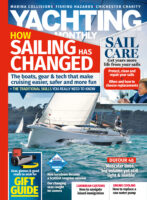The MG Spring 25 is a compact and affordable 1980s yacht perfectly designed for a spot of lively weekend family cruising – or racing...
MG Spring 25 used boat review: Does this TV star from the 80s still perform today?
Most of us can admit to having recently trawled through yacht ads on the internet. If my own experience is anything to go by, we do this out of interest and curiosity as much as we do to actually look for a new boat. And there are different approaches.
If you type ‘twin rudder shoal draught cruising yacht, 25ft length overall’ in to your search bar, the MG Spring 25 might not even be top of the results. I daresay you could scroll past it. But if you type in ‘yachts that starred in BBC TV show Howards’ Way’, the MG Spring 25 will be top billing.
You might well click on the accompanying image and the satisfaction may put you one step closer to a purchase.
Tony Castro’s prototype Spring of Tarrant was indeed a star of Howards’ Way. She typified the atmosphere of the Solent scene in the late 1980s. The synthesiser tunes and dissolving camera shots seemed to work with the Hamble River fog as nicely as dry ice in pop music videos.
But today’s not really a day for nostalgia. And we’re nowhere near the Hamble. Our example MG Spring 25, the 1988-built Tigger, is surging down the Exmouth Fairway Channel into Lyme Bay.
Tigger was one of the first run of Spring 25s initially marketed by MG. Not that nostalgia was anything to do with Rex Frost’s purchase in 2020. ‘We got the boat because of Covid,’ he recalls, in clipped Australian tones.
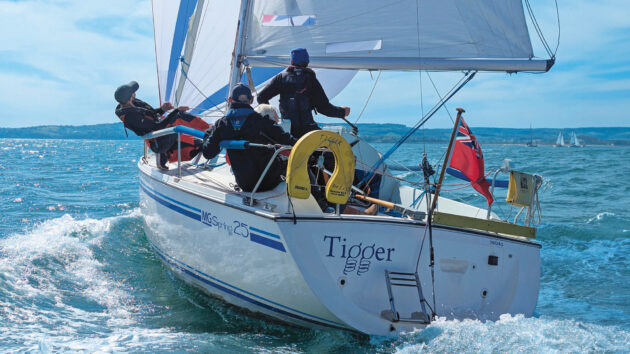
Picking up speed in light conditions
‘We’d just been let out. I can’t remember which particular lockdown. I wanted to go to France to sail and France wasn’t letting us in. I was getting tired of not having anything to do to fill in my time. I thought, why don’t I get a very cheap little boat and do it up.
‘I talked to my friends and my wife, of course, and said, if I buy the cheapest little boat I can find that sails decently, would you guys agree to help me do some jobs on it if it’s a wreck?
‘My wife and I went and looked at this particular boat in Brixham. There seemed to be several Spring 25s on the market at the time, but this was the only one that appealed to me. It wasn’t as bad as it might be, and it was a really cheap boat. I agreed to buy it. The owner seemed keen to get rid of it.’
Article continues below…
Boathandling
The wisdom of Rex’s purchase seems clear when Tigger is under full sail. It meets the key condition he sought during the search; indeed, the boat sails very well. Earlier in the day I’d watched an RS200 dinghy tack nimbly up the Exe fairway against a fairly chugging tide. Now the MG Spring 25 was showing that it was just as sprightly.
‘They’re fun to race,’ Rex declares. ‘They’re fast downwind and they’re not slow going to windward.’ His is a weatherly boat as well. ‘If you’re prepared to have a number three jib and all the rest of it, it will go to windward in a blow quite happily,’ he adds. ‘They’re not bad in really light winds either. The only vice is that if it’s light winds and you stall, the boat goes sideways until you get some speed up.’

Rex helps his crews transition from dinghy racing to yacht racing racing
After I hopped aboard from the photo RIB – judging the wavesets for the manoeuvre like a pilot boarding a tanker – it was clear that Rex’s claims for Tigger’s boathandling characteristics were well-founded. An MG Spring 25 is handy under sail, responsive at the helm, but not twitchy, and bouncy on the wavesets, but not flighty.
A good deal of canvas is on this cruiser-racer-weekender, she is stiff enough to be firm when hard on the wind, heeling at a moderate angle so the shallow leeward rudder blade is plumb vertical, and the windward one clear of the water so as to prevent any interference.
Spring 25s have very shallow wing keels – a stubby piece of iron that will look after the boat. Some reports say that if the boat is taken into too shallow water it will skim the ground rather than trowel into it. So far, so good, but Rex cautions that the keel has little grip when the boat stops.
‘Once it stalls, it doesn’t do anything. When you start off under motor, the prop wash goes between the two rudders, so you can’t steer until the boat moves.’
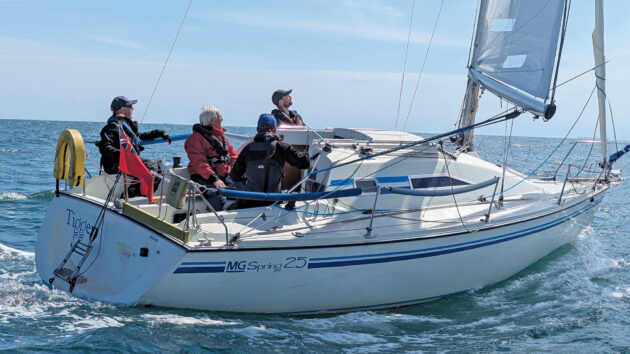
Spritely downwind and far from sluggish sailing to windward
In addition to the maintenance required on a GRP boat over several decades, Tigger has had a number of modifications under Rex’s stewardship. The previous owner had a much smaller bowsprit which flew what Rex calls a ‘tiny asymmetric’. Clearly he had an appetite for something larger. His friend and regular crew Jim Attrill almost doubled the length of the spar.
It serves its purpose well, although I couldn’t help noticing a certain curvature, and the fixture serving as the only ‘gammoning’ (lashing securing the bowsprit in place) gave the impression that if too much was asked of it, it would spring off the deck. But, if it all helps your boatspeed, why not?
Tigger’s spinnaker was acquired from eBay from a larger boat. ‘She slips along really well,’ says Rex, ‘and, thankfully, it doesn’t affect the handicap much.’ The main is a cut-down Etchells sail, which is ‘nice and powerful,’ says Rex.
I noticed the headboard catches on the backstay, but then I suppose the airflow over that snippet of sail doesn’t translate to much speed. ‘You have to have the top of the sail tidied up every couple of years,’ admits Rex. ‘But it doesn’t affect anything else.’
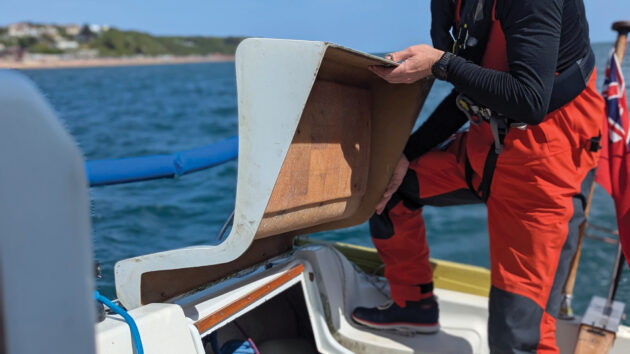
Deep cockpit locker to starboard
The other main modification has been to do away with the double mainsheet. The Spring 25’s original marketing argued that the double system freed up cockpit space eliminating any ‘paper guillotine’ effect from a traveller close to the companionway. But sheeting angles to the two alternative points well off the centreline were awkward and necessitated a convoluted arrangement for any gybe preventer. It was with this in mind that Rex’s team fitted a mainsheet traveller.
Chainplate
MG yachts were built light, and there were a few incidents early on with the model when masts were lost. Those losses were variously blamed on extrusion faults, chainplates being placed too tightly together, and even flexing hulls. Rex admits they had to do a big repair at the end of the last season when a chainplate on one side pulled out. He was aware of the boat’s track record.
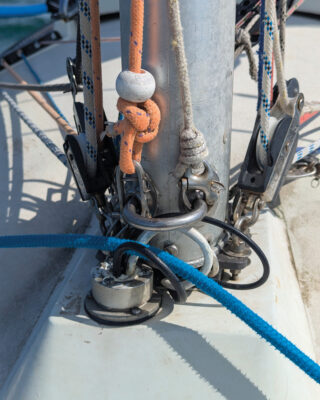
Early Spring 25s may need mast foot reinforcement
‘That was a well-known fault. When I bought the boat, we had a good look at it, and thought the boat had a modification to get around that. But then, off Dartmouth last year, the shroud finally pulled out. I had to nurse her all the way back home.’ I couldn’t see the subsequent repair, it being tucked away very neatly, but I have faith in Rex’s description of a ‘huge reinforcing frame’.
It’s instructive to see original advertising for the Spring 25. ‘£13,500 including VAT gets you a MG Spring 25. How do we manage this price? Well we’ve given you a weekend’s work to finish your spring. Boatyard labour is expensive. So we’ve left the costly finishing part to you. Your Spring 25 comes complete with a Trim Pack. This contains all the doors, fiddles, lockers etc all pre-varnished and the necessary screws and fittings.’
Rex was not one of those who snapped up these boats at the time – taking a screwdriver and hand-drill to put together the plywood panels. But he is a beneficiary of the economically-sound interior. ‘It sleeps four people very easily. And for a 25-footer, it’s got a heads and the galley. And a cool box. It’s got everything that a big boat would have. It hasn’t got a lot of storage if you want a long cruise, but as a weekender it’s brilliant.’
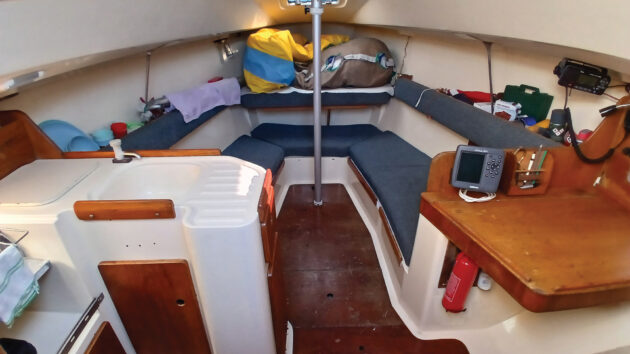
Full working galley yet still sleeps four
That’s not an endorsement of the original marketing (‘Roomy beyond belief’) but it is a measure of Rex’s ‘value for money’ satisfaction. Indeed his purchase point was at a very reasonable mid-point in the spread of available secondhand offerings at the time – comparable to the original 1988 price.
Family limitations
MG Yachts claimed six berths in two cabins but that would be a significant discomfort today. Rex says the settee berths in the saloon are okay for adults, and the ‘forepeak is big enough for two youngsters to sleep in.’
To my mind those adults in the saloon are going to be very cramped, even though the forepeak lip lifts up for more footroom. That also lengthens the forepeak berth. But it’s still difficult to see any but the youngest of children sleeping well in there.
The saloon berths are low to the cabin sole. There is a table which lowers on the mast support post to make a double berth. That table, however, is in Rex’s loft. The one currently used in the cabin is a modification from a previous owner.
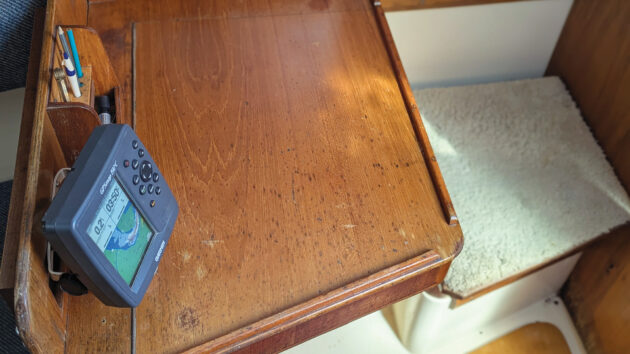
The forward facing chart table is small but practical
A two-burner galley and a forward-facing chart table are admirable, as are the commodious heads and wet-locker taking up the starboard aft area below. The rest of the starboard quarter is taken up by a single deep cockpit locker, where the engine start panel is located.
The interior port quarter is taken up by a big double cabin – immediately appreciated by Rex and his wife after the boat was bought in 2020. ‘While we were waiting for the French to let us travel, my wife and I went and had a weekend in Salcombe. And then, a couple of weeks later, we had a weekend in Lyme Regis. We were allowed to travel after that, and I left the boys to race it and work out what to do.’
Engine teething problems were sorted out very quickly after purchase. Rex and his friend Jim took the boat from Brixham to Exmouth. The Yanmar 1GM was, Rex says, ‘very reluctant to produce any power. We were a bit worried about the propeller. We did some work on the exhaust because it was all furred up or carboned up because the previous owner hadn’t run it much. But within a few weeks, we had it sorted out.’
The auxiliary engine is housed beneath the companionway, supplying relatively easy access. It powers a two-bladed folding prop on a P-bracket and a single 12V battery. A single-lever engine control is in the cockpit.

Slipping along nicely, under a large spinnaker bought on eBay and a cut-down Etchells mainsail
MG Spring 25 specifications
DESIGNER: Tony Castro
YEARS BUILT: 1986-88
LOA: 25ft 6in / 7.77m
LWL: 22ft 9in / 6.93m
BEAM: 9ft0in / 2.74m
DRAUGHT: 3ft 0in / 0.91m
DISPLACEMENT: 4,500 lbs / 2,000 kg
BALLAST: 1,540 lbs
SAIL AREA: 330 sq ft / 30.5 m²
PRICE: £7,000 to £12,000
Enjoyed reading this?
A subscription to Yachting Monthly magazine costs around 40% less than the cover price, so you can save money compared to buying single issues.
Print and digital editions are available through Magazines Direct – where you can also find the latest deals.
YM is packed with information to help you get the most from your time on the water.
-
-
- Take your seamanship to the next level with tips, advice and skills from our experts
- Impartial in-depth reviews of the latest yachts and equipment
- Cruising guides to help you reach those dream destinations
-
Follow us on Facebook, Twitter and Instagram.
Note: We may earn a commission when you buy through links on our site, at no extra cost to you. This doesn’t affect our editorial independence.
Verdict
Without doubt the MG Spring 25 is a fun little yacht. The name, taken from the character in Winnie the Pooh, well illustrates Tigger’s sense of playfulness. ‘I believe it was originally designed for a young family,’ says Rex. ‘And I think it would be ideal for that. You’ve got a big cabin for the parents and little bunks for kids. It's very easy to handle with only two people with an occasional young person to help.’ Rex is keen to point out that on the day when Yachting Monthly came to photograph his boat, there was anything but a typical crew aboard. ‘We usually have teenagers with us as well. We like to train 15-year-old dinghy sailors to yacht race. If they’re good we let them helm as well as winch. At present we have a girl who helmed a lot last year and is very keen to be the fastest female on the course,’ Rex smiles. ‘The crew, who race it more than I do, love it.’ It’s a cliche to say a yacht is like a big dinghy. Indeed it is difficult to see how some yachties intend this description to be some kind of pejorative phrase. In my view it’s always an asset. Yes, the Spring 25 is in many ways a big dinghy. But no, it’s certainly not recommended for a beginner, and it’s definitely not for extended offshore work. ‘Our prime consideration was to have something that would be fun to sail,’ says Rex. ‘And we certainly haven't regretted it.’

